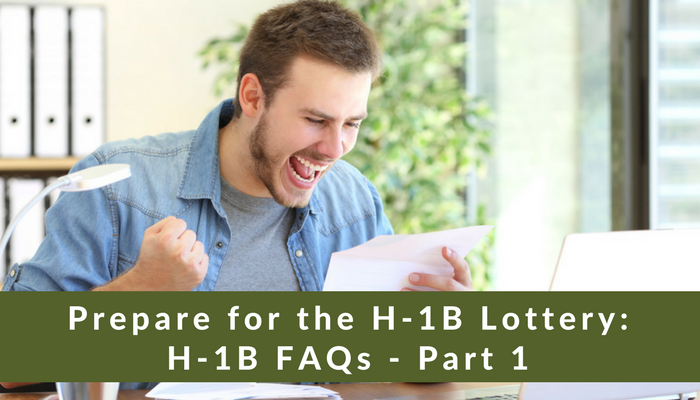 The demand for cap-subject H-1Bs continues to be high. Therefore, it is imperative that employers, employees, and their immigration counsel start petition preparations early.
The demand for cap-subject H-1Bs continues to be high. Therefore, it is imperative that employers, employees, and their immigration counsel start petition preparations early.
Job descriptions, salary, O*Net codes, Department of Labor (DOL) registration, the posting of required notices, and credential verification are only a few of the details that must be considered during preparation.
Read part 1 of our FAQs, and check back next month for part 2.
1. What is the H-1B visa?
The H-1B visa classification is designed for foreign workers who will be employed in a professional occupation that requires at least a bachelor’s degree or its equivalent and specialized knowledge.
2. How many H-1B visas are available?
There is an annual limit of 85,000 cap-subject H-1B visas available, which includes 65,000 visas for foreign nationals holding a bachelor’s degree or its equivalent (minus 6,800 carved out for Chile and Singapore H-1Bs) and 20,000 for those holding U.S. advanced degrees, such as a master’s.
This is what is known as the H-1B visa cap, which is congressionally mandated. However, not all H-1B visas are subject to this annual cap.
3. Who is not subject to this cap?
Certain petitions are exempt from this annual cap, including current H-1B holders who need an extension, are filing for a change of employer, or are filing amendments to the terms of employment (such as part-time to full-time or other material job changes).
Past H-1B holders who were already counted against the cap but did not use the full six-year stay are also exempt, and can apply to use the remainder of H-1B time.
Additionally, petitions filed by institutions of higher education, related or affiliated non-profit entities, non-profit research organizations, and governmental research organizations are exempt. USCIS recently published new rules which broaden these cap-exempt organizations.
4. When can I file for cap-subject H-1B visas?
USCIS’ fiscal year (FY) runs from October 1st to September 30th. H-1B petitions can only be filed within six months of the employment start date.
Thus, the filing period begins the first Monday in April. USCIS typically accepts H-1B cap-subject petitions for the first five business days. Because of the very short filing period and the considerable work required before filing, it is very important to start early to prepare a properly completed H-1B.
5. Will there be a lottery for H-1B visas?
For the past several years, demand has far exceeded the H-1B cap.
In 2017, 199,000 new cap-subject H-1B petitions were filed. In 2016, 236,000 were filed. In 2015, 233,000 petitions were filed. And, in 2014, 172,500 petitions were filed.
6. How does the lottery work?
USCIS conducts an electronic random selection (lottery) of the 20,000 advanced-degree petitions. Unselected petitions from the advanced-degree lottery are added to the electronic random selection process for the 65,000 general H-1B visas.
The selected petitions undergo a first screening to eliminate petitions that do not comply with the filing requirements. About two months after the lottery is completed, USCIS begins returning the unselected petitions along with the filing fees.
7. What happens if my petition is selected?
About two to three weeks after the completion of the lottery, USCIS will begin issuing receipt notices for the selected petitions. Those petitions filed using premium processing service will be processed first and receive the first notices.
The receipt notice has a 13-digit alphanumeric receipt number, such as “EAC-17-010-34567”. The three letters indicate the filing center: EAC for the Eastern Adjudication Center located in Vermont and WAC for the Western Adjudication Center located in California. The next two digits are the filing year. You can use this number to track the processing of the petition.
8. What is premium processing service?
Premium processing provides expedited handling for an additional $1,225 fee. It allows you to know the status of your petition within fifteen calendar days from USCIS’ acceptance of your filing. Traditional processing can take between five and six months.
9. Who should apply for an H-1B visa?
- Foreign students in the United States in F-1 status who have received their degree. Often these students are in F-1/OPT or CPT at the time of the H-1B visa filing.
- Professionals abroad seeking to come and work in the United States.
- Foreign nationals in the United States in other valid status, such as H-4, L-1, TN (Mexican and Canadian citizens), E-3 (Australian citizens), H-4 (H-1B dependents), E-1/E-2 (investors), and P-1 (athletes).